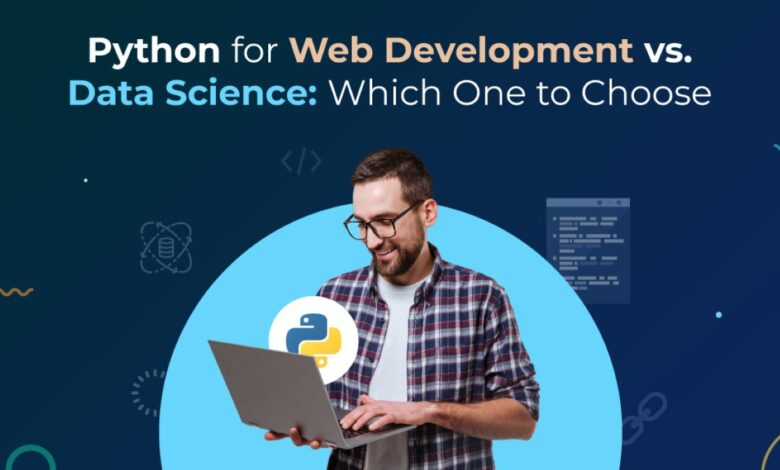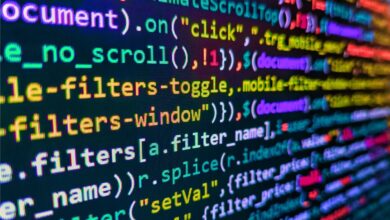Python for Web Development vs. Data Science: Which One to Choose

Python has remained one of the most popular programming languages in software development since its inception in 1991. Python is fairly well known for its web development capabilities. However, one of the biggest strengths of Python is its ability to adapt to new requirements and technologies. The biggest evidence of its adaptability and versatility to accommodate changing demands based on the project requirements is its application in data science. Today beyond the typical use case of web development, Python is actively used for data science, too.
However, it raises a much-needed question of where Python actually excels. The ongoing debate regarding Python’s application in web development vs data science adequately captures this notion perfectly. Is Python better for web development or data science? Given its track record, inherent attributes, and real-world success stories, there is a solid argument for both use cases. So, let’s analyze all relevant factors closely to finally settle whether Python is better for web development or data science.
Understanding Python’s Core Strengths
Python’s immense popularity is due to its fundamental traits and strength. One of its biggest strengths is its simplicity, which makes Python easy to learn. Further, an extensive library ecosystem, cross-platform compatibility, and its dynamic and flexible nature bestows Python a rare combination of desirable traits. These strengths become even more resounding with a huge online community to help fellow developers work with Python.
- Simplicity and Readability – Python’s syntax is extremely clear and concise, almost resembling natural language, allowing developers to write code that is easy to understand. Python excels in readability, with features like indentation and whitespace playing a crucial role in defining code blocks. Python’s simplicity and readability make maintaining and debugging code more manageable in the long run.
- Ease of Learning – Python’s straightforward syntax and focus on high readability and simplicity make it perfect for easy adoption. It enables beginners to build real-world applications by learning the basics quickly. The learning curve becomes even more gentle and easy with many tutorials, online courses, and documentation. All of it makes learning Python extremely accessible and engaging.
- Extensive Library Ecosystem and Community Support – Python has an extensive library ecosystem in the form of PyPI or Python Package Index. It offers pre-written code modules for various functionalities, making it a plug-and-play approach. On top of this, Python has a large and active community, providing invaluable support for both beginners and experienced developers. It makes Python extensively easy to work with for developers of all expertise.
- Cross-platform Compatibility – “Write once, run anywhere” is one of the significant strengths of Python that enables cross-platform compatibility. Developers don’t need to create separate versions of Windows, macOS, and Linux. This saves considerable development time and resources. This cross-platform compatibility has many benefits, such as simplified testing and deployment and increased application accessibility.
- Dynamic and Flexible Nature – Python is a dynamically typed language. This means you don’t need to declare variable types beforehand explicitly. This aids in rapid prototyping and experimentation during development. More than this, one of the biggest strengths of Python is its ability to evolve with changing needs. Developers can often adopt existing code to incorporate new features and libraries as projects grow.
Python in Web Development
With the availability of some robust frameworks such as Django and Flask, the role of Python in web development is significant. These two particular frameworks simplify and expedite the process of web application development. Django is known for its “batteries-included” approach, offering a comprehensive suite of tools and features. It includes an ORM (Object-Relational Mapping), authentication, and an admin interface right out of the box, making it ideal for quickly building complex and data-driven websites. On the other hand, Flask enables developers to use only the necessary components, adopting a more modular and flexible approach. It makes Flask ideal for simple and large-scale projects as a part of a more extensive set of microservices.
Pros of Using Python in Web Development
From rapid development capabilities to numerous libraries featuring pre-written codes, there are plenty of benefits to using Python, making it highly efficient for web development.
- Rapid Development Capabilities – The clear syntax and readability reduce the cognitive load of developers and make it a hassle-free experience to work with Python for web development. This allows developers to focus on innovation and features rather than complex code logic. On top of this, the extensive library allows for rapid development, prototyping, and faster building of web applications due to readily available tools and functionalities.
- Wide Range of Libraries and Middleware Support – What sets Python apart for web development is its extensive ecosystem of libraries and middleware. Developers can find a vast repository of pre-written code for various functionalities. This includes several essential features for web development, such as authentication, security, and more. This “plug-and-play” approach saves development time and effort, enabling rapid prototyping and testing.
- Strong Community and Documentation – Another strong suite of Python is its immense popularity in the tech Industry due to its application in varied areas, including web development. Beyond the pre-built components for specific tasks, there is a large online community with plenty of other resources, such as educational tutorials and forums dedicated to web development using Python. Thus, finding quick solutions to everyday problems and learning the best practices are convenient.
These are just a few pros in the long list of benefits that make Python for Web development a logical choice. Developers can improve their execution and reap the advantage of rapid prototyping by acquainting themselves with popular frameworks. Even though Python itself is a simple and easy-to-learn language, a thorough understanding of its most popular frameworks is necessary to achieve the desired results. A detailed comparison of Python’s popular frameworks, such as Django, Flask, and FastAPI, can be a great starting point to build your understanding. An in-depth understanding of these popular frameworks will further help in writing flawless code, speedier execution, and applying innovative solutions.
Challenges and Considerations: Python for Web Development
Despite its many advantages, using Python for web development comes with challenges that developers must consider beforehand. CPU-intensive operations may need to be improved due to Python’s interpretative nature compared to other compiled languages, such as C++ or JavaScript. It may lead to performance issues. High-traffic websites can be challenging to maintain, given Python’s dynamic nature and single-threaded execution model. It can impact a website’s ability to manage simultaneous processes efficiently.
However, hiring expert Python developers can resolve all these issues. It will enable companies to harness innovative solutions, such as asynchronous and event-driven programming models. This further enhances performance and the ability to handle high traffic. Further, deploying applications in a load-balanced, multi-server environment helps tackle these issues efficiently.
Real-world Success Stories
The practical application of Python in web development and numerous real-world success stories are evidence of Python’s web development capabilities. The success of the big platforms, such as Spotify and The Washington Post, that use Django reflects the ability of Python and its frameworks to adapt and scale, meeting the demanding cycles and high developer productivity.
- Instagram – One of the world’s largest social media platforms, Instagram was built using Django. It shows the framework’s scalability and robustness in handling millions of users and interactions.
- Pinterest – It is a popular visual discovery platform that relies on Django for its backend infrastructure, demonstrating its versatility in supporting complex web applications. Further, it uses Flask to scale its operations and serve millions of users around the globe.
Python in Data Science
Python has been a dominant force in data science, becoming the default language choice for data scientists, analysts, and AI researchers. This preference for Python is due to its versatility, readability, and the comprehensive libraries it offers that perfectly match the requirements for data analysis, machine learning, and artificial intelligence. There are dedicated libraries that facilitate complex data manipulation and analysis, making cleaning, transforming, and aggregating data easy and efficient. Further, there are tools for statistical analysis, predictive modeling, and deep learning. This ecosystem makes Python an invaluable tool for extracting insights from data and developing predictive models.
Pros of Using Python for Data Science
There are plenty of inherent benefits of using Python for data science. Python covers all bases, from seamless integration with data visualization tools to extensive libraries that offer the right tools for the task.
- Extensive Data Science Libraries – The most significant advantage of Python for data science is its vast library. Libraries like NumPy, Pandas, SciPy, Scikit-learn, and TensorFlow offer pre-built functions and tools for various data science tasks. This includes basic data manipulation and complex machine-learning algorithms. This vast and robust ecosystem of libraries significantly reduces development time. This allows data scientists to focus more on analyzing data and less on coding from scratch.
- Integration with Data Visualization – Another hallmark of Python that makes it apt for data science is its seamless integration with data visualization tools and platforms, such as Matplotlib and Seaborn. This enables the creation of insightful visualization that can turn complex datasets into understandable plots and charts. All of this together facilitates cohesive data interpretation and storytelling. Consequently, it allows data scientists to communicate findings effectively.
- Strong Support for Scientific Computing – Python offers libraries like SciPy that feature advanced mathematical functions and algorithms commonly used in scientific computing. It makes Python well-suited for data science tasks that involve complex calculations. Python’s strong support for scientific computing, highlighted by its widespread adoption in academia and research, makes it a powerful tool for conducting scientific experiments and simulations. This solidifies its position as a leading language in data science.
Challenges and Consideration: Python for Data Science
Python has several benefits when used for data science projects, but it is not without Challenges. The specialized data science libraries can present a steep learning curve for those new to data science or Python. It requires time and effort to become proficient in using these tools effectively. Further, Python’s dynamic nature and garbage collection mechanism can lead to inefficiencies that can present problems in managing large datasets and performance optimization. Thus, it can slow down the progress of the project. Programmers can resolve these challenges through practices like vectorization with libraries, such as Dask or multiprocessing. However, a seamless execution of these best practices is only possible with experience. Thus, for large-scale and complex projects, companies should avail of Python development services to overcome this challenge. This will ensure timely completion and polished execution overall.
Case Studies Showcasing Python for Data Science Projects
Numerous case studies across industries amply showcase the effectiveness of Python in data science. These case studies highlight the effectiveness of Python for data science in real-world projects. It emphasizes the role of Python in enabling data-driven decision-making, personalized user experience, and advanced machine learning applications. Further, in health, researchers can use libraries such as Biopython to conduct genomic data analysis for advanced personalized medicine.
- Instagram – One of the most popular social media apps, Instagram leverages Python for data analysis and machine learning tasks. It showcases the language’s ability to handle massive amounts of data and generates personalized recommendations.
- Spotify – One of the most popular music streaming apps, Spotify uses Python for its music recommendation algorithm by employing libraries like TensorFlow to analyze user data and deliver personalized playlists.
Comparative Analysis: Python for Web Dev or Data Science?
Python offers several benefits for both web development and data science. However, to understand whether Python is more suitable for web development or data science, we need to look at several factors that will give a clear picture.
- Community and Learning Resources – Python enjoys immense popularity online due to its vibrant and extensive community. Python for web development has libraries like Django and Flask with dedicated communities. These offer comprehensive documentation, tutorials, and forums. These helpful resources make it easier for developers to enter the field and for experienced developers to solve complex issues. For data science, there is robust community support through libraries such as pandas, NumPy, Scikit-learn, and TensorFlow, each with vast learning resources and active forums for discussion.
As Python has plenty of resources via community resources, the major difference lies like community engagement. The web development discussion delves into best practices for server setup or user authentication, whereas data science forums often delve into statistical analysis, machine learning algorithms, and data manipulation techniques.
- Scalability and Performance Considerations – Scalability and performance are critical to both domains but play out differently. Python for web development is ideal for rapid development but, due to its dynamic nature, can introduce challenges in handling large volumes of requests as efficiently as some compiled languages. However, Python web applications can quickly scale efficiently using asynchronous programming and microservices.
On the other hand, data science projects involving large datasets or complex computations usually face performance issues due to Python’s interpretative nature. However, programmers can quickly mitigate this by leveraging libraries optimized for performance, such as NumPy, or using C extension and distributed computing frameworks.
- Project Complexity and Development Time – Due to its simple syntax and the extensive suite of Libraries, python significantly reduces development time in web development and data science. Python for web development enables rapid prototyping and deployment using numerous frameworks that follow the “batteries-included” approach. It is a crucial advantage, especially for startups and companies looking to save time, money, and effort for quickly launching their products.
Python’s simplicity is a huge advantage in data science, enabling researchers and data scientists to focus on data analysis rather than the intricacies of programming. It makes for a streamlined process from data exploration to model deployment. The complexity of projects can vary widely in both domains, but Python’s comprehensive ecosystem and community support system make tackling complex challenges more manageable.
Conclusion
Python, with its inherent benefits, such as an extensive ecosystem of libraries, strong community support, and seamless integration with data visualization platforms, makes it ideal for web development and data science projects. Barring a few challenges, Python is apt for both web development and data science due to its inherent characteristics. Python for web development has frameworks, such as Django and Flask. On the other hand, Python has NumPy, Pandas, and SciPy for data science.
At the core of things, Python’s strength lies in its versatility, extensive support system, and the simplicity of its syntax. These core attributes lend well to both web development and data science projects. It is not the case of declaring whether Python is better for web development and data science. The decision to use Python for web development or data science ultimately depends on the project requirements, complexities, team expertise, and specific goals.



